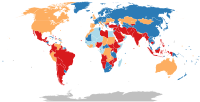
Photo from wikipedia
Abstract A novel damage detection and localisation method, the so-called Deformation Area Difference method for localisation of damages in bridge structures is introduced. The method is based on static load-deflection… Click to show full abstract
Abstract A novel damage detection and localisation method, the so-called Deformation Area Difference method for localisation of damages in bridge structures is introduced. The method is based on static load-deflection experiments with the prerequisite of high precise deflection measurement. This study presents the first experiences of applying the DAD method on a real bridge structure. The investigated structure is a prestressed concrete slab bridge with a span of about 27 m, which was built in 2013. The loading on the bridge is applied using six heavy trucks, each weighing up to 32 t. A wide range of the modern measurement technologies were used to achieve high precision measurements of the bridge deflection along the longitudinal axis, namely the photogrammetry using a big size drone, laser scanner, total station, levelling and displacement sensors. The performed load-deflection test was non-destructive since the maximum deformation did not exceed the serviceability limit state. The exercise of the novel damage detection and localisation method on a real structure initiated further optimisation opportunities of the DAD method and the study of its limits. Several boundary conditions and methodical influence factors related to the applicability of the proposed method were analysed, such as impacts of measurement precision, damage degree, the position of damage, and the number of measurement repetitions.
Journal Title: Engineering Structures
Year Published: 2020
Link to full text (if available)
Share on Social Media: Sign Up to like & get
recommendations!